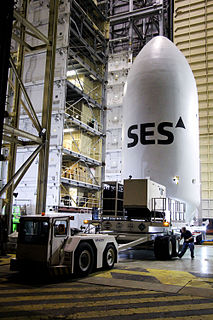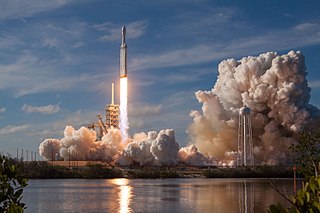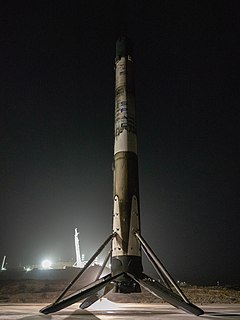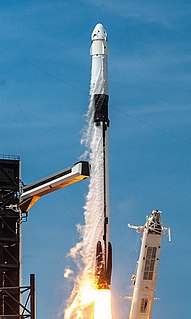
A reusable launch system is a launch system that allows for the reuse of some or all of the component stages. To date, several fully reusable suborbital systems and partially reusable orbital systems have been flown.

Falcon 9 is a partially reusable two-stage-to-orbit medium-lift launch vehicle designed and manufactured by SpaceX in the United States. The latest version of the first stage can return to Earth and be flown again multiple times. Both the first and second stages are powered by SpaceX Merlin engines, using cryogenic liquid oxygen and rocket-grade kerosene (RP-1) as propellants. Its name is derived from the fictional Star Wars spacecraft, the Millennium Falcon, and the nine Merlin engines of the rocket's first stage. The rocket evolved with versions v1.0 (2010–2013), v1.1 (2013–2016), v1.2 Full Thrust (2015–present), including the Block 5 Full Thrust variant, flying since May 2018. Unlike most rockets in service, which are expendable launch systems, since the introduction of the Full Thrust version, Falcon 9 is partially reusable, with the first stage capable of re-entering the atmosphere and landing vertically after separating from the second stage. This feat was achieved for the first time on flight 20 in December 2015. Since then, SpaceX has successfully landed boosters dozens of times, with individual first stages flying as many as ten times.

Falcon Heavy is a partially reusable heavy-lift launch vehicle designed and manufactured by SpaceX. It is derived from the Falcon 9 vehicle and consists of a strengthened Falcon 9 first stage as the center core with two additional Falcon 9-like first stages as strap-on boosters. Falcon Heavy has the highest payload capacity of any currently operational launch vehicle, and the third-highest capacity of any rocket ever to reach orbit, trailing the Saturn V and Energia.

Several new rockets and spaceports began operations in 2016.

The SpaceX reusable launch system development program is a privately funded program to develop a set of new technologies for an orbital launch system that may be reused many times in a manner similar to the reusability of aircraft. SpaceX has been developing the technologies over several years to facilitate full and rapid reusability of space launch vehicles. The project's long-term objectives include returning a launch vehicle first stage to the launch site in minutes and to return a second stage to the launch pad following orbital realignment with the launch site and atmospheric reentry in up to 24 hours. SpaceX's long term goal is that both stages of their orbital launch vehicle will be designed to allow reuse a few hours after return.

SpaceX CRS-8, also known as SpX-8, was a Commercial Resupply Service mission to the International Space Station (ISS) which was launched on April 8, 2016, at 20:43 UTC. It was the 23rd flight of a Falcon 9 rocket, the tenth flight of a Dragon cargo spacecraft and the eighth operational mission contracted to SpaceX by NASA under the Commercial Resupply Services program. The capsule carried over 3,100 kilograms (6,800 lb) of cargo to the ISS including the Bigelow Expandable Activity Module (BEAM), a prototype inflatable space habitat delivered in the vehicle's trunk, which will be attached to the station for two years of in-orbit viability tests.

SpaceX CRS-5, also known as SpX-5, was a Commercial Resupply Service mission to the International Space Station (ISS), conducted by SpaceX for NASA, and was launched on 10 January 2015 and ended on 11 February 2015. It was the seventh flight for SpaceX's uncrewed Dragon cargo spacecraft and the fifth SpaceX operational mission contracted to NASA under an ISS resupply services contract.

Falcon 9 v1.1 was the second version of SpaceX's Falcon 9 orbital launch vehicle. The rocket was developed in 2011–2013, made its maiden launch in September 2013, and its final flight in January 2016. The Falcon 9 rocket was fully designed, manufactured, and operated by SpaceX. Following the second Commercial Resupply Services (CRS) launch, the initial version Falcon 9 v1.0 was retired from use and replaced by the v1.1 version.

The Falcon 9 first-stage landing tests were a series of controlled-descent flight tests conducted by SpaceX between 2013 and 2016. Since 2017, the first stage of Falcon 9 missions has been routinely landed if the rocket performance allowed it, and if SpaceX chose to recover the stage.

An autonomous spaceport drone ship (ASDS) is an ocean-going vessel derived from a deck barge, outfitted with station-keeping engines and a large landing platform and is autonomously controlled when on station for a landing. Construction of such ships was commissioned by aerospace company SpaceX to allow recovery of launch vehicle first stages at sea for missions that do not carry enough fuel to return to the launch site after boosting spacecraft onto an orbital or interplanetary trajectory.
Eutelsat 115 West B is a communications satellite that is operated by Eutelsat, providing video, data, government, and mobile services for the Americas. The satellite was designed and manufactured by Boeing Space Systems, and is a Boeing 702SP model communication satellite. It is located at 115 degrees west longitude. It was launched on board a SpaceX Falcon 9 rocket on 2 March 2015.

ABS, formerly Asia Broadcast Satellite, is a global satellite operator based in Hong Kong and officially incorporated in Bermuda. Its services include direct-to-home and satellite-to-cable TV distribution, cellular services, and internet services. Operating 6 communication satellites, the satellite fleet currently covers 93% of the world's population including the Americas, Africa, Asia Pacific, Europe, the Middle East, Russia and Commonwealth of Independent States.

SES-9 is a geostationary communications satellite operated by SES S.A. It was launched from Cape Canaveral SLC-40 by a Falcon 9 Full Thrust launch vehicle on 4 March 2016.

Falcon 9 flight 20 was a Falcon 9 space launch that occurred on 22 December 2015 at 01:29:00 UTC. It was the first time that the first stage of an orbital rocket made a successful return and vertical landing.

Falcon 9 Full Thrust is a partially reusable medium-lift launch vehicle, designed and manufactured by SpaceX. Designed in 2014–2015, Falcon 9 Full Thrust began launch operations in December 2015. As of 13 November 2021, Falcon 9 Full Thrust had performed 108 launches without any failures. Based on the Lewis point estimate of reliability, this rocket is the most reliable orbital launch vehicle currently in operation.

The Falcon Heavy test flight was the first attempt by SpaceX to launch a Falcon Heavy rocket on February 6, 2018 at 20:45 UTC. The successful test introduced the Falcon Heavy as the most powerful rocket in operation, producing five million pounds-force (22 MN) of thrust and having more than twice the lift capacity of United Launch Alliance's Delta IV Heavy.

Falcon 9 booster B1048 was a reusable orbital-class Block 5 Falcon 9 first-stage booster manufactured by SpaceX. B1048 was the third Falcon 9 Block 5 to fly and the second Block 5 booster to re-fly. It became the second orbital-class booster to fly a third time and is the first booster ever to be launched five times. B1048 service came to an end on its fifth flight when an engine shut down prematurely on launch. Whilst the primary mission was unaffected and the Starlink payload deployed successfully, B1048 was unable to land. In a subsequent investigation, SpaceX found that isopropyl alcohol, used as cleaning fluid, was trapped and ignited causing the engine to be shut down. To address the issue, in a following launch SpaceX indicated that the cleaning process was not done.

Falcon 9 Block 5 is a partially reusable two-stage-to-orbit medium-lift launch vehicle designed and manufactured in the United States by SpaceX. It is the fifth version of Falcon 9 Full Thrust, powered by SpaceX Merlin engines burning rocket-grade kerosene (RP-1) and liquid oxygen (LOX).

















